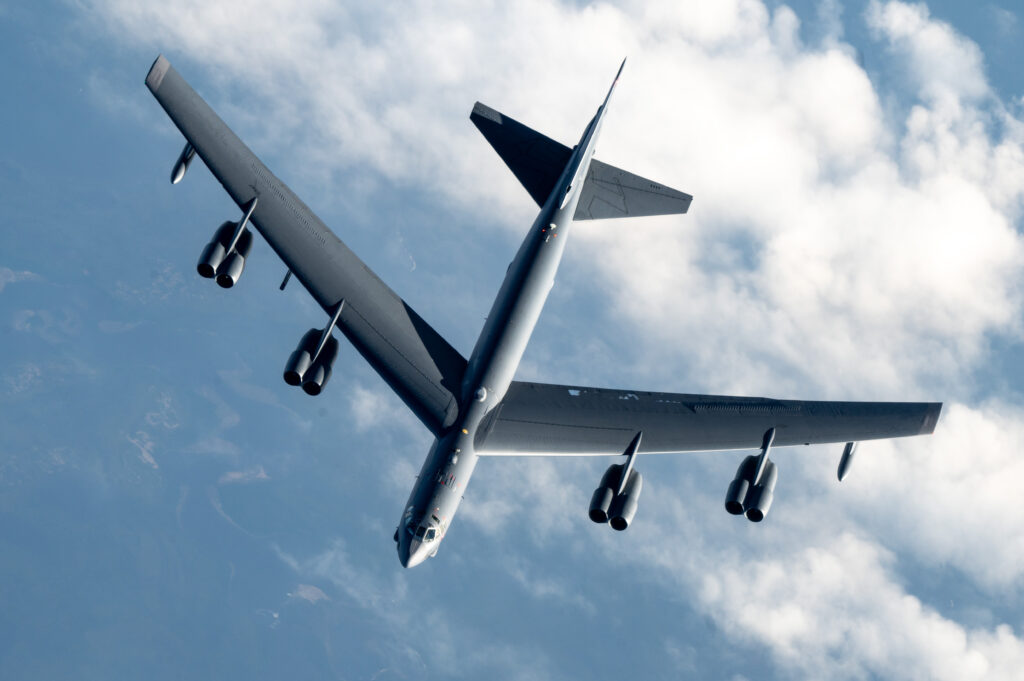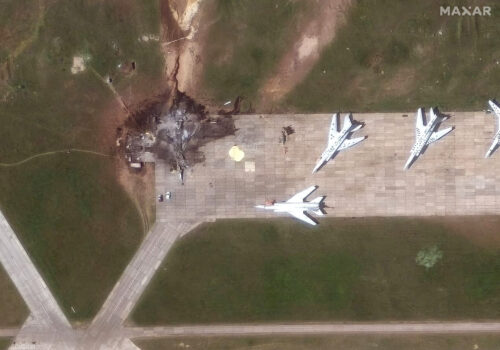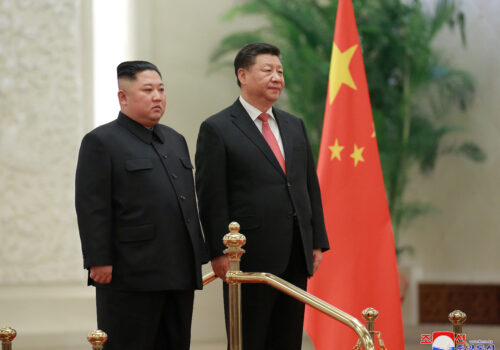When it comes to nuclear weapons, does the United States need more or different nuclear capabilities than already planned? For decades, nuclear experts have debated and disagreed over the details of the US nuclear arsenal. But the past eighteen months have seen a growing convergence among nuclear deterrence experts around what is being called a “new American nuclear consensus.”
Citing the 2023 Final Report of the Congressional Commission on the Strategic Posture of the United States (SPC), the nuclear experts in this “consensus” camp posit that there is broad support for a host of actions regarding the future of the US nuclear arsenal. In their telling, this includes support for delivering the full existing nuclear modernization program, increasing warhead capacity within the legacy and the modernized nuclear force, and further adding both nonstrategic and strategic capabilities to the future force. These experts call for Washington to dispense with another policy review and start implementing the actions.
Many within the nuclear policy community, both Republican and Democrat, see this as a moment of agreement and resolve. In August 2024, former Acting Assistant Secretary of Defense for Space Policy Vipin Narang said that the United States’ “current nuclear force posture and plan[ned] modernization program is necessary but may well be insufficient in the coming years.” However, it is not clear that the Trump administration, Pentagon policymakers, or the American people in general have bought into a commitment for additional nuclear capabilities.
Put me in the camp that believes more nuclear capabilities are needed—both in terms of quality and quantity. The United States and the West face a revisionist Russia that is a peer nuclear power, as well as a China that seeks to displace the United States as the leading world power and is on the path to equaling or exceeding the size of the US deployed nuclear force. Moreover, Washington cannot sleep on Pyongyang, which is continuing its nuclear buildup, posing unique deterrence challenges to the United States, South Korea, and the region.
It is imperative that those outside of the nuclear expert community understand why the United States needs new or different nuclear forces to confront these threats. First, any crisis or conflict with either Russia or China will immediately put the United States at risk of strategic deterrence failure against one and potential opportunistic aggression from the other. Second, to credibly deter an adversary from nuclear escalation, the United States needs more flexibility in its available responses than it has with its current and anticipated nuclear arsenal. Third, with the expected growth of China’s nuclear arsenal, the United States will need sufficient capabilities, both qualitatively and quantitatively, to continue to simultaneously deter Russia and China in the decades to come.
This is not the first time the United States has had to consider significant new nuclear investments. When US President Ronald Reagan took office in 1981, a perceived decline in US strategic capabilities relative to the Soviets led him to announce—and then Secretary of Defense Caspar Weinberger to develop—a comprehensive plan to revitalize the entire strategic deterrent force. But there was little doubt at that time that the Reagan administration was intent on expanding US nuclear capabilities based on presidential campaign rhetoric and the administration’s early actions.
How broad is the new consensus?
The Trump administration has so far not indicated that it supports significant new nuclear investments. Although complying with congressional direction to pursue a nuclear sea-launched cruise missile (SLCM-N), the Trump administration has not publicly advocated for expanding the existing nuclear modernization program of record. In February, US President Donald Trump said “There’s no reason for us to be building brand new nuclear weapons. We already have so many.” And in March, US Secretary of Energy Chris Wright said, “So what we need to do now is just modernize. We don’t need to grow our nuclear stockpile but modernize our weapons.” Moreover, the pending presidential budget request is flat for the base defense budget. Any uptick in funding would likely come from the so-called reconciliation bill, which is more likely to be a one-off spending increase than the sustained support needed over years for new nuclear capabilities.
Moreover, it is not clear that nonnuclear experts and decision makers support the nuclear consensus. The National Defense Strategy (NDS) Commission generally endorsed the findings of the SPC in a July 2024 report, stating that “it is existential for U.S. national security that [the nuclear] modernization programs continue at pace to preserve the strategic deterrent.” However, not only did the commission not endorse additional nuclear capabilities, it stated that the modernization effort should not “come at the expense of modernizing and expanding the Navy and Air Force conventional forces.”
Perhaps the biggest hurdle to the new consensus is the fact that most Department of Defense (DoD) officials with responsibility for Pentagon strategy, force development, and budget decisions are generally not steeped in nuclear deterrence issues. These officials are less likely than many nuclear experts to see the risk of two simultaneous or near-simultaneous nuclear wars as realistic. They also tend to believe that the United States already has enough nuclear capabilities to deter multiple adversaries. Some may see any increase in US nuclear capabilities as license for Russia and China to further grow their forces, and many simply prioritize modernizing, expanding, and diversifying the nation’s nonnuclear capabilities.
When budgets are tight and it comes time to spend the next incremental dollar on military capabilities, one cannot count on the nuclear consensus to guarantee that it will be spent on new nuclear capabilities. Strengthening nuclear deterrence, therefore, will require convincing officials responsible for strategy, force development and budget decisions across the US government of the risk of nuclear deterrence failure and the need to prioritize, as appropriate, nuclear over nonnuclear expenditures.
Making the case
Three overlapping audiences must be convinced. First, there are nonnuclear strategists in the Pentagon and those who have primary responsibility for formulating the DoD’s annual budget requests, particularly the military services. Second is the Office of Management and Budget, which sets administration funding priorities. Third, there are senior administration leaders, including the secretary of defense and the president.
Arguments familiar to nuclear strategists must be recalibrated to convince these decision makers of the need for additional investment in nuclear capabilities critical to the United States’ overall deterrence and defense posture. To reach these audiences, nuclear experts should focus on three core arguments.
1. Nuclear weapons have a critical role from the start of a crisis
The first use of nuclear weapons, in the words of renowned strategist Herman Kahn, “is likely to be less for the purpose of destroying the other’s military forces or handicapping its operations” than to influence adversary decision makers. Thus, nuclear escalation will be a concern from the moment Washington confronts a nuclear-armed adversary in a crisis or conflict. Since any conflict between the United States and either Russia or China will most likely grow from a regional spark, their perceived stake in the conflict will likely be existential from the moment it begins. Both nations have developed doctrines and capabilities to match their anticipated stake in a regional conflict, including nuclear capabilities. They recognize that, when war comes, defeat along their periphery could be devastating to the future viability of their polity. Thus, from the conflict’s inception, nuclear capabilities are on the table. US leaders need to recognize this, as US success in conventional conflict will tempt adversary escalation, potentially earlier than anticipated.
2. The nuclear arsenal underpins the US ability to conduct conventional operations
If an adversary is tempted to escalate its way out of a failed or failing conventional conflict, it is critical that the president have at his disposal forces that provide him the tools needed to deter such behavior. To quote a phrase attributed to Victor Mikhailov, a senior official in the Soviet Union’s nuclear weapons program during the Cold War, “Russia has a nuclear scalpel for every military problem in Europe.” As described in the SPC Report, such diverse nuclear capabilities offer “options to deter adversaries, control the escalation of potential hostilities, and counter U.S. and allied conventional forces.” The United States needs a similarly flexible—though not identical—toolkit so that the president has the ability to credibly and effectively deter Russia (or China, which is expanding its own nuclear surgical kit) from using one of their nuclear scalpels. And, if deterrence does fail, the president needs flexible tools to restore deterrence without making a general nuclear exchange inevitable.
The United States does not have that flexibility today—nor is it likely to have it once the nuclear modernization program is complete, even with the eventual deployment of SLCM-N. This should matter to nonnuclear strategists, as the goal is to deter adversary nuclear employment in the first instance and, if deterrence fails, to expeditiously restore deterrence in a way that preserves for regional commanders the freedom of action necessary to prosecute their conventional plans to a successful conclusion. Said another way, nuclear weapons underpin the United States’ ability to successfully conduct conventional operations.
3. China’s growing nuclear arsenal changes what the US needs
In a face-off against one nuclear-armed peer, there is a risk that the second will take advantage of a distracted United States to pursue its own regional objectives through military aggression. Should this occur, the United States will be faced with the challenge of simultaneously deterring two adversaries from conducting strategic attacks against the homeland during a time of war—adversaries whose forces pose an existential threat to the United States. As long as damage limitation and imposing intolerable costs remain central tenets of US nuclear strategy, the United States must maintain a credible capability to hold at risk what Russia and China value most, including their strategic forces.
But the United States’ ability to do so is on track to dissipate due to the growth of China’s arsenal and the fact that the number of US weapons available for counterforce targeting in the 2030s and 2040s is likely to be smaller than it is today. With a reduced ability to credibly deter adversary attacks on the US homeland, US decision makers may be hesitant to rigorously defend US global interests against nuclear-backed conventional threats, rendering any future US conventional superiority chimerical.
Each of these arguments demonstrates the importance of nuclear forces that are qualitatively and quantitatively sufficient to enable freedom of military action in a confrontation with a peer nuclear-armed adversary in the coming decades. Such a nuclear force is not what the United States fields today, and it is not the force that Washington will have when the currently planned modernization program is complete. To get there, more and different US nuclear capabilities are needed, which will require convincing the broader defense community of the importance of additional nuclear investments.
Paul Amato is the former director for nuclear deterrence policy in the Office of Secretary of Defense for Policy. He is a retired Marine infantry officer with twenty-eight years of active and reserve service. Before his government service, he was a practicing lawyer in the private sector. The views expressed in this article are his own.
Further reading
Wed, Apr 3, 2024
The US is building a nuclear sea-launched cruise missile. Congress must make sure it’s built right.
New Atlanticist By Robert Soofer
There are forces at play—bureaucratic, budgetary, and programmatic—that could stymie the SLCM-N if US lawmakers do not pay close attention.
Fri, Jun 6, 2025
Ukraine’s drone strikes offer four big lessons for US nuclear strategists
New Atlanticist By Mark J. Massa
Ukraine’s Operation Spiderweb should spur the US government to address strategic vulnerabilities that nuclear strategists have focused on for years.
Mon, May 12, 2025
A rising nuclear double-threat in East Asia: Insights from our Guardian Tiger I and II tabletop exercises
Report By Markus Garlauskas, Lauren D. Gilbert, Kyoko Imai
A decade from now, the United States will face even tougher challenges in the Indo-Pacific than it does today. With this in mind, the Atlantic Council's Guardian Tiger tabletop exercise series is preparing mid-level government and military leaders to address such threats.
Image: A US Air Force B-52 Stratofortress departs after being refueled by KC-135 Stratotanker over the Pacific Northwest July 18, 2024. The 92nd Air Refueling Wing and 141st ARW’s ability to rapidly generate airpower at a moment’s notice was put to the test when Air Mobility Command’s Inspector General team conducted a no-notice Nuclear Operational Readiness Inspection, July 16–18, 2024. (US Air Force photo by Staff Sgt. Lawrence Sena)




